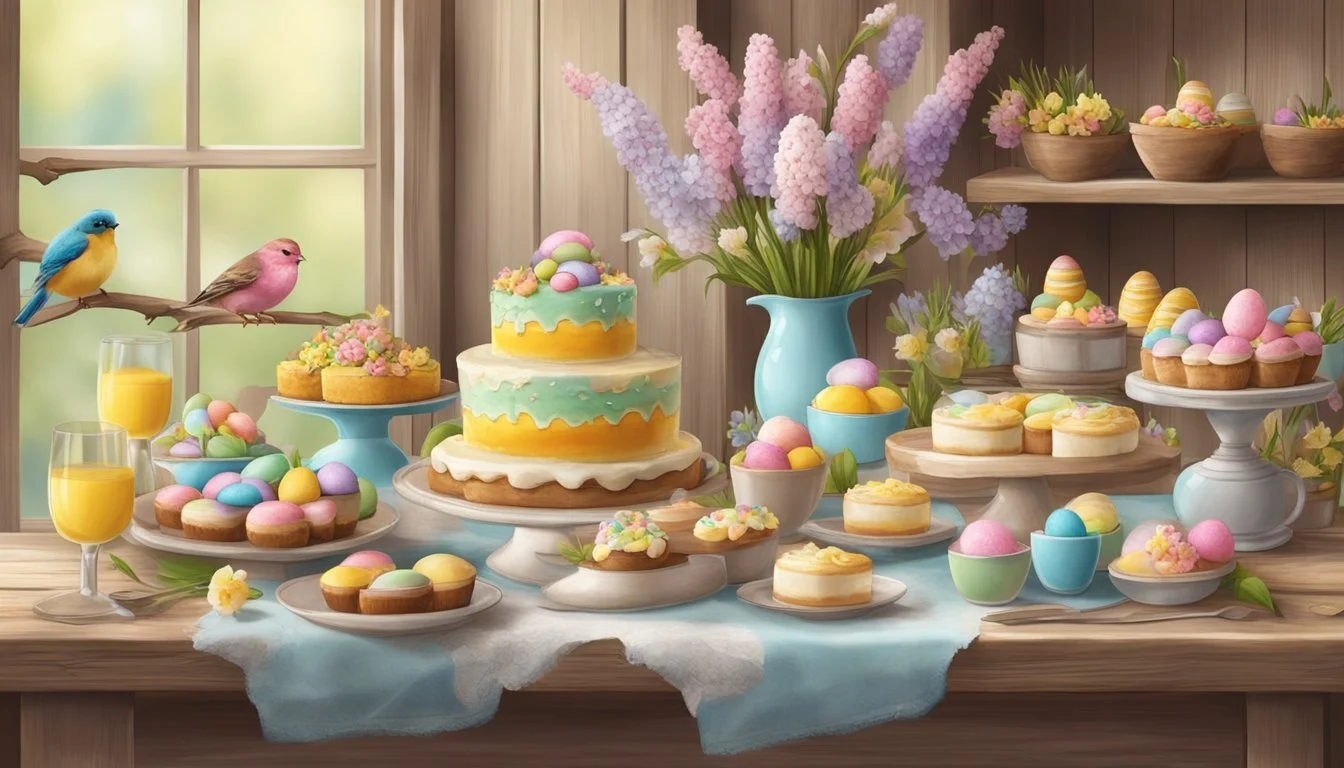A Taste of Easter
Country Desserts and Sweet Treats Unveiled
Easter celebrations around the world are rich with diverse traditions and customs, particularly when it comes to desserts (What wine goes well with desserts?) and sweet treats. Each country brings its own flavor to the table, creating a mosaic of culinary traditions that mark this festive holiday. From the spiced aroma of hot cross buns in the United Kingdom, signaling the end of Lent, to the colorful Monas de Pascua in Spain, Easter desserts are more than just food; they are symbols of cultural heritage and joyous celebration.
In the United States, the holiday is often accompanied by the creation of classic confections such as marshmallow bunnies and chocolate-covered eggs. The delight of finding these treats in Easter baskets is matched only by the joy of gathering around the table to enjoy a slice of carrot cake topped with creamy cream (how long does cream last?) cheese frosting. The desserts not only satisfy sweet tooths but also act as centerpieces for the festive occasion, bringing together family and friends over shared dishes that have been passed down through generations.
Easter's culinary delights have become an anticipated part of the holiday's celebration. They reflect the sentiments of the season—rebirth, renewal, and the gathering of loved ones. With each bite, these desserts invite a moment of reflection on the past and a sweet anticipation for the future.
The Essentials of Easter Desserts
Easter desserts are a colorful showcase of spring flavors and ingredients. This section will explore the key components and techniques that turn these treats into festive centerpieces.
Ingredients and Flavor Profiles
The foundation of Easter desserts often begins with classic ingredients such as eggs, butter, sugar, and flour. Eggs add richness and structure to recipes like the traditional German Osterbrot, a brioche-like bread, while butter imparts a tender crumb to cakes (how long do cakes last?) and pastries. Sugar brings sweetness, often balanced with the addition of vanilla for depth or lemon for a citrusy zing.
Ingredient Role in Baking Common Easter Dessert Eggs Structure, richness Osterbrot Butter Tenderness, flavor Pound Cake Sugar Sweetness, texture Lemon Pie Bars Vanilla Flavor depth Various Cakes and Cookies Lemon Tartness, freshness Lemon Pie Bars Chocolate Richness, indulgence Easter-themed Confections
Flavor profiles range from the decadent appeal of chocolate in Easter confections to the light and zesty notes of lemon in pie bars. The season is celebrated with an array of desserts from various cultures, each bringing their unique take on Easter sweets.
Baking Techniques and Tips
Precision and timing are crucial in baking, especially when dealing with intricate Easter recipes. One key technique is the proper creaming of butter and sugar for cakes to ensure a perfect rise and texture. When making enriched bread such as Osterbrot, patience during the proofing process allows the dough to develop the right texture and flavor.
Bakers should make certain that eggs are at room temperature for optimal incorporation into doughs and batters. For example:
Pound Cake: Cream room temperature butter and sugar until light and fluffy.
Lemon Pie Bars: Mix the filling until smooth, then bake until just set for the ideal texture.
Additionally, for meringues or dairy-free desserts calling for whipped coconut cream, chilling the equipment and ingredients beforehand can greatly enhance the final product's quality.
By adhering to the flavors and techniques characteristic of Easter desserts, bakers can ensure that their sweet creations embody the joy and renewal celebrated during this springtime holiday.
Classic Easter Recipes
Easter desserts are a delightful tradition, bringing sweetness and festivity to the holiday table. With a focus on classic flavors and time-honored preparations, these treats span from moist cakes to flaky pastries to decorative cookies that capture the essence of Easter.
Cakes and Frostings
Easter celebrations often feature a Carrot Cake with Cream Cheese Frosting, a staple for its moist crumb and rich, tangy frosting often adorned with walnuts. Chocolate Cake also makes a frequent appearance, satisfying those who crave a deep, cocoa-rich dessert.
Carrot Cake: Spiced with cinnamon and nutmeg, filled with shredded carrots (how long do carrots last?), and topped with a smooth cream cheese frosting.
Chocolate Cake: Layers of dark, moist chocolate cake with a velvety and often Easter-themed decoration.
Pies and Pastries
Heading into the world of pies and pastries, one finds flakey crusts and creamy fillings that define Easter's sweet end. Cheesecake is a luxurious option, with its creamy texture and the potential for fruit or chocolate embellishments. Traditional pies, whether fruit-filled or custard-based, are a tribute to the seasonal produce.
Cheesecake: A rich, creamy dessert on a crumbly, buttery base, sometimes topped with berries or chocolate.
Hot Cross Buns: A spiced sweet bun typically made with currants or raisins, marked with a cross on the top, and consumed on Good Friday.
Cookies and Confections
Lastly, Easter isn't complete without a selection of Easter cookies ranging from intricately iced sugar cookies to themed confections like macaroon nests. These sweet treats are not only delicious but also serve as edible decorations, often coming in shapes of bunnies, eggs, and chicks.
Easter Cookies: Decorative sugar cookies shaped in Easter themes, along with nest-like cookies filled with miniature eggs.
Macaroon Nests: Chewy coconut macaroon cookies shaped like nests, typically housing small candy eggs, blending texture with whimsy.
Each dessert category encompasses a rich heritage of family gatherings and festivities, creating a sweet tapestry of tradition and taste.
Innovative Twists on Traditional Treats
Modern bakeries are embracing the challenge of reinventing Easter classics with a focus on inclusivity and a dash of bold new flavors. These inventive versions ensure that everyone can enjoy a sweet treat during the holiday, without compromising on taste or tradition.
Gluten-Free and Vegan Options
When it comes to gluten-free and vegan Easter treats, there is an abundance of options gracing the holiday tables. Bakeries might offer gluten-free hot cross buns using a blend of rice and coconut flour, ensuring that the texture remains fluffy and the taste, authentic. For those seeking egg-free and dairy-free treats, vegan carrot cakes have become a staple, complete with cashew or almond-based cream cheese frosting.
Gluten-free options:
Hot cross buns using alternative flours
Cakes made with rice or coconut flour
Vegan options:
Carrot cakes with nut-based frosting
Pastries made without dairy or eggs
Exotic Flavors and Textures
Easter isn’t just for the traditional palate anymore; exotic flavors from around the world are making their appearance. Berries and fresh fruit infusions bring a refreshing twist to classic desserts; imagine a lemon cake bursting with blueberry swirls, or panna cotta topped with a vibrant mango compote. Even the humble chocolate easter egg has been elevated, now featuring infusions of unexpected flavors like lavender or chili.
Textures:
Crunch from nuts or candies
Silkiness from coconut milk-based creams
Flavors:
Citrus zest in baked goods
Spices like cardamom or saffron in pastries
Decorative Desserts for Easter
Decorative desserts for Easter not only delight the taste buds but also serve as festive centerpieces. They bring a bright and joyous spirit to any Easter gathering with their vibrant colors and creative designs.
Elegant Presentation Ideas
One can create Easter sugar cookies that are both delicious and visually stunning. The cookies can be cut into Easter-themed shapes like bunnies, eggs, and chicks, and decorated with royal icing and colorful sprinkles. The key here is precision in the icing process to ensure each cookie is a miniature work of art.
For meringues, their elegant swirls and peaks lend themselves to pastel color themes typical of Easter. Meringue nests can be made to hold small chocolate eggs or jellybeans. They’re not only delectable but also add a sophisticated touch to the dessert table.
DIY Edible Easter Decorations
Creating edible decorations allows for an interactive element to Easter festivities. Marshmallows can be cut into fun shapes and dipped into colored sugar or decorated with edible paint to resemble Easter animals. These marshmallow creations can adorn cakes and cupcakes or be served on their own as a whimsical treat.
Marzipan, a pliable almond-based confection, can be sculpted into various shapes and figures associated with Easter. Bunnies, eggs, and flowers made from marzipan can be intricately painted and placed on desserts or used as standalone edible decorations. Using marzipan allows for a high level of detail, making it perfect for intricate designs.
By focusing on these decorative touches, one elevates simple desserts to festive confections that capture the essence of Easter.
Complementary Pairings and Serving Suggestions
Easter desserts are best enjoyed with thoughtful pairings that enhance their flavors. This section provides specific suggestions for Easter brunch (What wine goes well with brunch?) and the ideal beverages to serve with your sweet treats.
Easter Brunch Ideas
Fruit-topped Cream Pie: A light and airy cream pie topped with fresh berries makes for a stunning Easter brunch dessert. It pairs excellently with whipped cream to add a touch of decadence.
Vanilla Ice Cream with Hot Cross Buns: Serve warm hot cross buns with a scoop of vanilla ice cream for a comforting and creamy combination.
Easter Desserts Table:
Dessert Suggested Pairing Notes Pastel Butter Cookies Fresh Berries The tartness balances the sweetness. Carrot Cake Whipped Cream with a Hint of Cinnamon Adds a spiced contrast to the cake.
Beverage Matchups for Desserts
Tea and Coffee: For those serving rich and flavorful Easter desserts, a cup of black tea or freshly brewed coffee provides a robust contrast that cleanses the palate.
Dessert Wines: A sweet Moscato or a dessert Riesling can complement lighter desserts like lemon bars, adding a fruity and floral note that echoes the springtime spirit.
Dessert Type Beverage Suggestion Reasoning Chocolate-Based Dark Roast Coffee The bitterness offsets the sweet chocolate. Fruit-Infused Sparkling Water with Citrus Enhances the desserts' fruit notes. Creamy and Rich Sweet Dessert Wine Matches the dessert's sweetness and texture.
Practical Tips for a Delightful Easter Table
Creating a captivating Easter table involves not only appealing presentation but also an understanding of how to effectively set up a buffet and maintain food safety. Strategic layout and proper handling ensure the Easter feast is both beautiful and enjoyable.
Setting Up the Easter Buffet
Layout: One begins by arranging the buffet table in an accessible area within the kitchen or dining space to enable smooth flow of the guests. They should use a long tablecloth to drape the buffet table, leaving approximately a foot of material on the ground to conceal any storage or supplies hidden underneath.
Organization: They should group dishes by category and course – appetizers near the starting point, entrées in the middle, and desserts at the end. It's beneficial to place hot dishes on warming trays and position flatware at the end of the table so guests can grab utensils after their plates are full.
Serving Dishes and Utensils:
Flatware: Rolled in napkins and arranged in a basket
Plates: Stacked at the beginning of the buffet line
Napkins: Arranged at either end for easy access
Decorations: Subtle Easter-themed decorations add to the atmosphere. One could scatter colored eggs or edible treats along the table, interspersed with small bouquets of spring flowers in mason jars for a splash of color.
Food Safety and Storage
Temperature: They should keep cold dishes chilled and hot dishes warmed appropriately. For instance, one could use refrigerated serving platters for items like salads and a slow cooker to maintain the temperature of hot foods.
Storage: Post-meal, any leftovers should be promptly stored in the refrigerator to prevent spoilage. It's advised to divide large quantities into shallow containers to cool quickly and evenly.
Safe Timeframe:
Cold Foods: No longer than two hours at room temperature
Hot Foods: No longer than one hour if the temperature is above 90°F
Hygiene: Cleanliness in the kitchen during preparation and service is crucial. They should regularly wash hands and use clean utensils to handle different dishes to prevent cross-contamination.
By carefully planning the Easter table and adhering to these practical tips, they create not only an inviting display but a safe and enjoyable dining experience for their guests.
Sweet Conclusions
Easter desserts often captivate with their velvety textures and sublime flavors. This section hones in on practical advice for crafting flawless desserts and appreciating the customs they embody.
Troubleshooting Common Dessert Problems
When a custard turns grainy or a cake collapses, dessert makers may question their technique. Below are solutions to these common setbacks:
Custard Consistency Issues:
Grainy Texture: Ensure the mixture isn't overheated. Stir custards (how long do custards last?)over medium heat and remove as soon as they coat a spoon.
Curdling: This can be prevented by tempering eggs before joining them with hot liquid.
Cake Challenges:
Collapsed Center: Make sure to check the expiration date on baking powder or soda, and avoid opening the oven door too frequently during baking.
Dry Texture: Proper measuring is crucial. Use a knife to level off cups of flour to ensure precise amounts.
Reflecting on Easter Traditions
Easter confections are not just desserts; they are cultural staples that reflect generations of tradition.
Cakes as Centerpieces: Many cultures serve cakes at Easter festivities; they range from rich, buttery bases to light, airy sponges.
Symbolism in Sweet Treats: Desserts during Easter may symbolize renewal and celebration, showcasing springtime motifs through the use of pastel icing or Easter-themed decorations.
These treats unite families, offering a sweet conclusion to festive meals while honoring the essence of tradition and togetherness.









